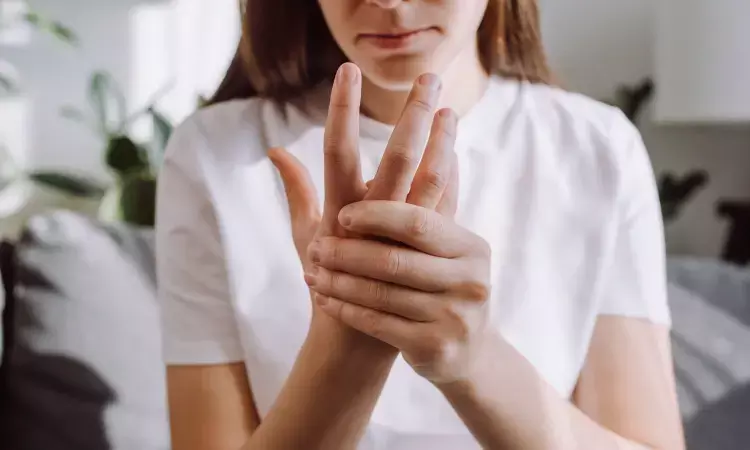- Home
- Medical news & Guidelines
- Anesthesiology
- Cardiology and CTVS
- Critical Care
- Dentistry
- Dermatology
- Diabetes and Endocrinology
- ENT
- Gastroenterology
- Medicine
- Nephrology
- Neurology
- Obstretics-Gynaecology
- Oncology
- Ophthalmology
- Orthopaedics
- Pediatrics-Neonatology
- Psychiatry
- Pulmonology
- Radiology
- Surgery
- Urology
- Laboratory Medicine
- Diet
- Nursing
- Paramedical
- Physiotherapy
- Health news
- Fact Check
- Bone Health Fact Check
- Brain Health Fact Check
- Cancer Related Fact Check
- Child Care Fact Check
- Dental and oral health fact check
- Diabetes and metabolic health fact check
- Diet and Nutrition Fact Check
- Eye and ENT Care Fact Check
- Fitness fact check
- Gut health fact check
- Heart health fact check
- Kidney health fact check
- Medical education fact check
- Men's health fact check
- Respiratory fact check
- Skin and hair care fact check
- Vaccine and Immunization fact check
- Women's health fact check
- AYUSH
- State News
- Andaman and Nicobar Islands
- Andhra Pradesh
- Arunachal Pradesh
- Assam
- Bihar
- Chandigarh
- Chattisgarh
- Dadra and Nagar Haveli
- Daman and Diu
- Delhi
- Goa
- Gujarat
- Haryana
- Himachal Pradesh
- Jammu & Kashmir
- Jharkhand
- Karnataka
- Kerala
- Ladakh
- Lakshadweep
- Madhya Pradesh
- Maharashtra
- Manipur
- Meghalaya
- Mizoram
- Nagaland
- Odisha
- Puducherry
- Punjab
- Rajasthan
- Sikkim
- Tamil Nadu
- Telangana
- Tripura
- Uttar Pradesh
- Uttrakhand
- West Bengal
- Medical Education
- Industry
IV golimumab for juvenile idiopathic arthritis in shows effective risk-benefit profile: Study

A new study published in the Journal of Rheumatology unveiled that intravenous golimumab for juvenile idiopathic arthritis in a long-term extension trial had an acceptable risk-benefit profile.
Juvenile idiopathic arthritis (JIA) is the most prevalent rheumatologic disorder in children and is classified into three subtypes, namely, polyarticular, oligoarticular, and systemic onset. The patients with polyarticular JIA have a variety of etiologic risk factors, distinct disease courses, and treatment obstacles. The children with polyarticular JIA often have a more refractory course when compared to children whose joints are not as damaged. They have a longer course of active illness, which puts them at higher risk of joint injury and worse functional results as well as a lower quality of life.
This study by Hermine Brunner and the team evaluated the pharmacokinetics (PK), clinical effect, immunogenicity, and safety of intravenous (IV) golimumab in children with active polyarticular-course juvenile idiopathic arthritis (pcJIA) who took part in the open-label, long-term extension (LTE) of GO-VIVA (a medication to treat active polyarticular-course juvenile idiopathic arthritis) through week 252.
The participants in GO-VIVA who kept receiving IV golimumab (80 mg/m2 every 8 weeks) following week 52 were included in this trial. Clinical response was evaluated through week 116, while PK and safety were evaluated through weeks 244 (final dosage) and 252, respectively. Clinical outcomes measured were the clinical juvenile arthritis disease activity score in 10 joints (cJADAS10) and JIA–American College of Rheumatology (ACR) responses. Non-responder imputation was employed for binary outcomes, whereas observed data was utilized for other descriptive analyses.
69 individuals who entered the LTE and finished the week 252 visit comprised 112/127 (88.2%). From week 52 to week 244, golimumab concentrations at the median steady-state trough were mostly maintained. Also, the frequencies of antigolimumab antibodies were stable between weeks 52 and 244.
Up to week 116, when the median cJADAS10 was 1.6 and 56.7% (72/127) of individuals attained cJADAS10 < 5 (low disease activity), week 52 JIA-ACR 30/50/70/90 response rates were mostly sustained. Through week 252, the rates of major adverse events and severe infections were 7.7 and 3.9, per 100 patient-years, respectively. Overall, the data of this study demonstrate that IV golimumab therapy gives a long-term clinical outcome through week 116, with a satisfactory risk-benefit profile.
Source:
Brunner, H. I., Pacheco-Tena, C., Louw, I., Vega-Cornejo, G., Alexeeva, E., Appenzeller, S., Chasnyk, V., Griffin, T., Navarrete Suarez, C., Knupp-Oliveira, S., Zeft, A., Butbul Aviel, Y., De Ranieri, D., Gottlieb, B. S., Levy, D. M., Rabinovich, C. E., Artur Silva, C., Spivakovsky, Y., Uziel, Y., … Ruperto, N. (2024). Intravenous Golimumab in Children With Polyarticular-Course Juvenile Idiopathic Arthritis: Long-Term Extension of an Open-Label, Phase III Study. In The Journal of Rheumatology (p. jrheum.2024-0298). The Journal of Rheumatology. https://doi.org/10.3899/jrheum.2024-0298
Neuroscience Masters graduate
Jacinthlyn Sylvia, a Neuroscience Master's graduate from Chennai has worked extensively in deciphering the neurobiology of cognition and motor control in aging. She also has spread-out exposure to Neurosurgery from her Bachelor’s. She is currently involved in active Neuro-Oncology research. She is an upcoming neuroscientist with a fiery passion for writing. Her news cover at Medical Dialogues feature recent discoveries and updates from the healthcare and biomedical research fields. She can be reached at editorial@medicaldialogues.in
Dr Kamal Kant Kohli-MBBS, DTCD- a chest specialist with more than 30 years of practice and a flair for writing clinical articles, Dr Kamal Kant Kohli joined Medical Dialogues as a Chief Editor of Medical News. Besides writing articles, as an editor, he proofreads and verifies all the medical content published on Medical Dialogues including those coming from journals, studies,medical conferences,guidelines etc. Email: drkohli@medicaldialogues.in. Contact no. 011-43720751


